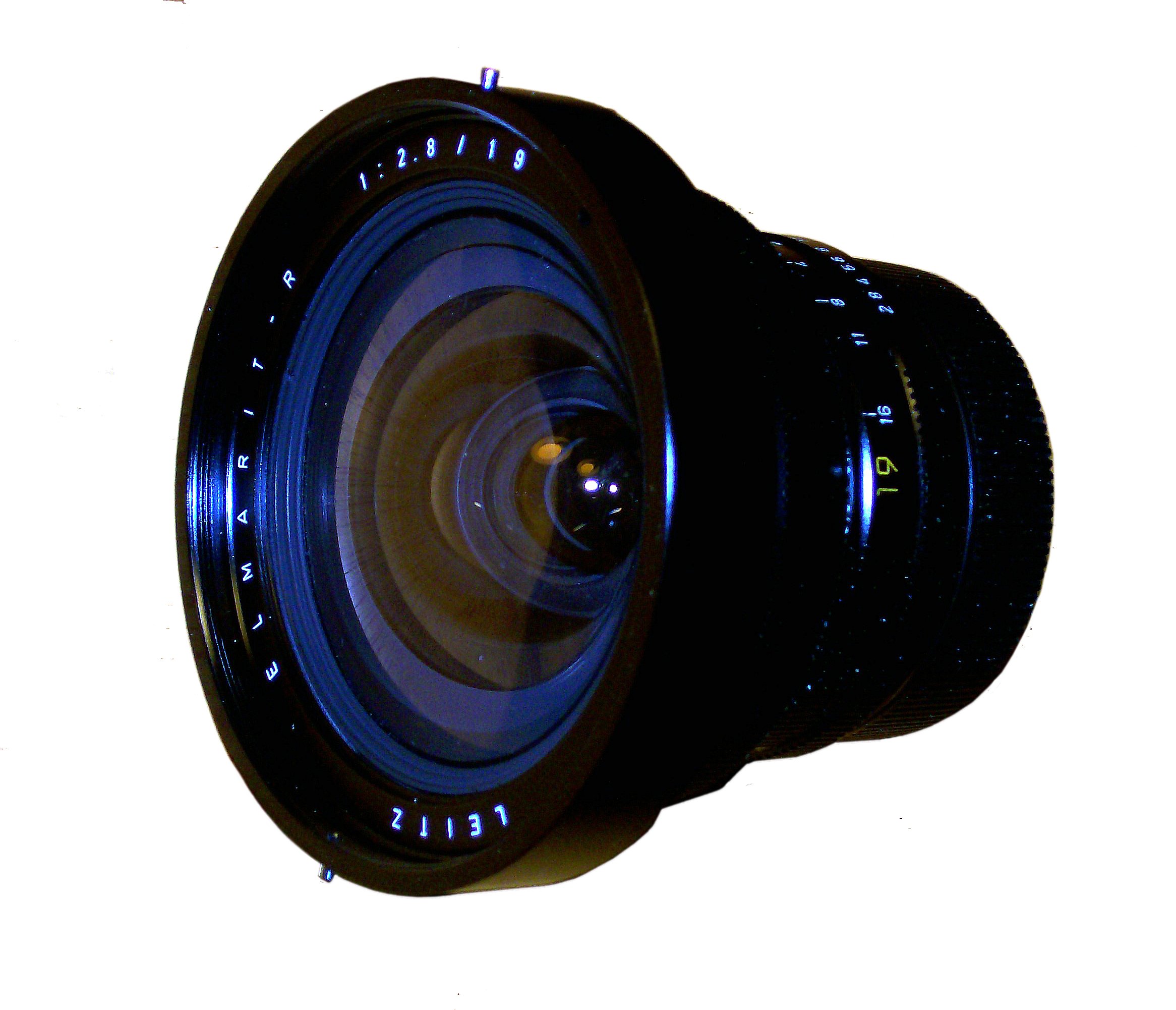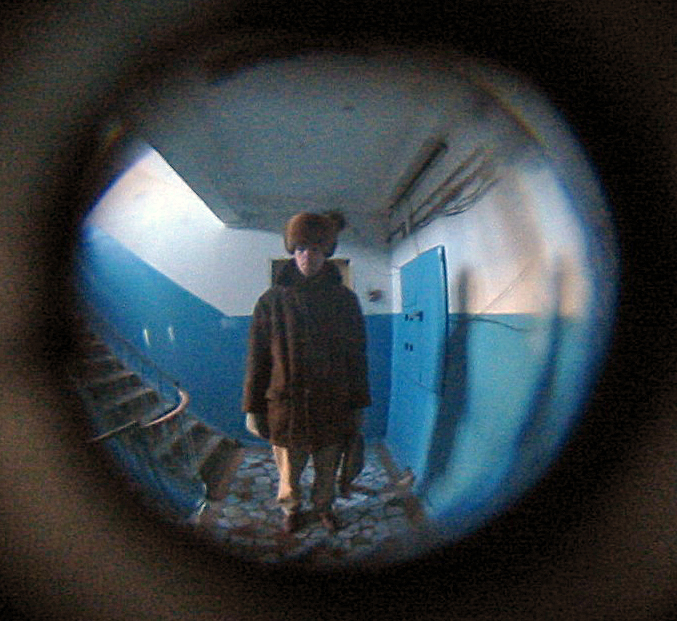|
Fisheye Lens
A fisheye lens is an ultra wide-angle lens that produces strong visual distortion intended to create a wide panoramic or hemispherical image. Fisheye lenses achieve extremely wide angles of view, well beyond any rectilinear lens. Instead of producing images with straight lines of perspective ( rectilinear images), fisheye lenses use a special mapping ("distortion"; for example: equisolid angle, see below), which gives images a characteristic convex non-rectilinear appearance. The term ''fisheye'' was coined in 1906 by American physicist and inventor Robert W. Wood based on how a fish would see an ultrawide hemispherical view from beneath the water (a phenomenon known as Snell's window). Their first practical use was in the 1920s for use in meteorology to study cloud formation giving them the name "whole-sky lenses". The angle of view of a fisheye lens is usually between 100 and 180 degrees, although lenses covering up to 280 degrees exist (see below). Their focal lengths dep ... [...More Info...] [...Related Items...] OR: [Wikipedia] [Google] [Baidu] |
Ultra Wide Angle Lens
An ultra wide-angle lens is a lens whose focal length is shorter than that of an average wide-angle lens, providing an even wider view. The term denotes a different range of lenses, relative to the size of the sensor in the camera in question. * For 1" any 9mm or shorter is considered ultra wide angle. * For 4/3" any 10 mm or shorter lens is considered ultra wide angle. * For APS-C any lens shorter than 15 mm. * For 35mm film or full-frame sensor any lens shorter than 24 mm * For 6x4.5 cm any lens shorter than 41 mm * For 6x6 cm and 6x7 cm any lens shorter than 56 mm Features 'Fisheye' and rectilinear lenses Ultra-wide angle lenses come in two varieties: Fisheye lenses with curvilinear barrel distortion, and rectilinear lenses which are designed so that straight lines in the scene will render straight (uncurved) in the photographic image and thus lack the extreme distortion that is characteristic of a fisheye lens. Neither denotes a particular ran ... [...More Info...] [...Related Items...] OR: [Wikipedia] [Google] [Baidu] |
CMOS
Complementary metal–oxide–semiconductor (CMOS, pronounced "sea-moss", ) is a type of metal–oxide–semiconductor field-effect transistor (MOSFET) fabrication process that uses complementary and symmetrical pairs of p-type and n-type MOSFETs for logic functions. CMOS technology is used for constructing integrated circuit (IC) chips, including microprocessors, microcontrollers, memory chips (including CMOS BIOS), and other digital logic circuits. CMOS technology is also used for analog circuits such as image sensors (CMOS sensors), data converters, RF circuits (RF CMOS), and highly integrated transceivers for many types of communication. The CMOS process was originally conceived by Frank Wanlass at Fairchild Semiconductor and presented by Wanlass and Chih-Tang Sah at the International Solid-State Circuits Conference in 1963. Wanlass later filed US patent 3,356,858 for CMOS circuitry and it was granted in 1967. commercialized the technology with the trademark "COS-MO ... [...More Info...] [...Related Items...] OR: [Wikipedia] [Google] [Baidu] |
AEG Weitwinkelobjectiv (1932)
Allgemeine Elektricitäts-Gesellschaft AG (AEG; ) was a German producer of electrical equipment founded in Berlin as the ''Deutsche Edison-Gesellschaft für angewandte Elektricität'' in 1883 by Emil Rathenau. During the Second World War, AEG worked with the Nazi Party and benefited from forced labour from concentration camps. After World War II, its headquarters moved to Frankfurt am Main. In 1967, AEG joined with its subsidiary Telefunken AG, creating ''Allgemeine Elektricitäts-Gesellschaft AEG-Telefunken''. In 1985, Daimler-Benz purchased the ''AEG-Telefunken Aktiengesellschaft'' (which was renamed to ''AEG Aktiengesellschaft'') and wholly integrated the company in 1996 into Daimler-Benz AG (1998: DaimlerChrysler). The remains of AEG became part of Adtranz (later Bombardier Transportation) and Deutsche Aerospace (1998: DASA, today part of Airbus SE). After acquiring the AEG household subsidiary AEG Hausgeräte GmbH in 1994, Electrolux obtained the rights to the AEG brand ... [...More Info...] [...Related Items...] OR: [Wikipedia] [Google] [Baidu] |
Stereoscopy
Stereoscopy (also called stereoscopics, or stereo imaging) is a technique for creating or enhancing the illusion of depth in an image by means of stereopsis for binocular vision. The word ''stereoscopy'' derives . Any stereoscopic image is called a stereogram. Originally, stereogram referred to a pair of stereo images which could be viewed using a stereoscope. Most stereoscopic methods present a pair of two-dimensional images to the viewer. The left image is presented to the left eye and the right image is presented to the right eye. When viewed, the human brain perceives the images as a single 3D view, giving the viewer the perception of 3D depth. However, the 3D effect lacks proper focal depth, which gives rise to the Vergence-Accommodation Conflict. Stereoscopy is distinguished from other types of 3D displays that display an image in three full dimensions, allowing the observer to increase information about the 3-dimensional objects being displayed by head and eye mov ... [...More Info...] [...Related Items...] OR: [Wikipedia] [Google] [Baidu] |
Whole Sky Camera
A whole sky camera is a specialized camera used in meteorology and astronomy for capturing a photograph of the entire sky. Another application is that of hemispherical photography to study plant canopy geometry and to calculate near-ground solar radiation. Development Whole sky cameras typically use a fisheye lens that takes in an extremely wide, hemispherical image. Such lenses were originally developed for use in meteorology. However, alternative techniques are based on the photography of a mirror-like hemisphere which are more common. One of the first reported whole sky cameras was based on a series of pictures with lenses inclined to the horizon at an altitude of 45 degrees. With a lens that covers an angular field of 90 degrees, such camera revolves about a vertical axis. Meteorological applications In meteorological applications, whole sky cameras are used to study cloud cover, the current level of UV radiation, fractional cloud coverage, sky polarization, the computation o ... [...More Info...] [...Related Items...] OR: [Wikipedia] [Google] [Baidu] |
Meniscus Lens
A lens is a transmissive optical device which focuses or disperses a light beam by means of refraction. A simple lens consists of a single piece of transparent material, while a compound lens consists of several simple lenses (''elements''), usually arranged along a common axis. Lenses are made from materials such as glass or plastic, and are ground and polished or molded to a desired shape. A lens can focus light to form an image, unlike a prism, which refracts light without focusing. Devices that similarly focus or disperse waves and radiation other than visible light are also called lenses, such as microwave lenses, electron lenses, acoustic lenses, or explosive lenses. Lenses are used in various imaging devices like telescopes, binoculars and cameras. They are also used as visual aids in glasses to correct defects of vision such as myopia and hypermetropia. History The word ''lens'' comes from '' lēns'', the Latin name of the lentil (a seed of a lentil plant ... [...More Info...] [...Related Items...] OR: [Wikipedia] [Google] [Baidu] |
R & J Beck
Richard Beck (1827-1866) and Joseph Beck FRAS, FRMS (June 1828-18 April 1891) (nephews of J. J. Lister) formed the optical manufacturing firm of R and J Beck in 1843, based at 69 Mortimer Street, London,. James Smith worked with the company under the name of Smith and Beck, renamed Smith, Beck and Beck in 1854 but reverting to R and J Beck when Smith retired in 1865. Smith is credited with helping to raise the status of the use of microscopes within scientific research. Exhibitions and trades shows * 1851 Great Exhibition Notable equipment Camera lenses of R and J Beck are known as Beck Ensign, and the Frena camera was developed in the 1890s, using celluloid films. catalogue of workby R & J Beck from 1900 has been digitised as part of the Internet Archive which features the terms of business and pricing from 1900, simplex microscopes, No. 10 London Microscope, No. 22 London Microscope, No. 29 London Microscope, Beck Pathological Microscope, No. 3201 Massive Microscope, Rad ... [...More Info...] [...Related Items...] OR: [Wikipedia] [Google] [Baidu] |
Hill Sky Lens (1924)
A hill is a landform that extends above the surrounding terrain. It often has a distinct summit. Terminology The distinction between a hill and a mountain is unclear and largely subjective, but a hill is universally considered to be not as tall, or as steep as a mountain. Geographers historically regarded mountains as hills greater than above sea level, which formed the basis of the plot of the 1995 film ''The Englishman who Went up a Hill but Came down a Mountain''. In contrast, hillwalkers have tended to regard mountains as peaks above sea level. The ''Oxford English Dictionary'' also suggests a limit of and Whittow states "Some authorities regard eminences above as mountains, those below being referred to as hills." Today, a mountain is usually defined in the UK and Ireland as any summit at least high, while the official UK government's definition of a mountain is a summit of or higher. Some definitions include a topographical prominence requirement, typically or ... [...More Info...] [...Related Items...] OR: [Wikipedia] [Google] [Baidu] |
Chromatic Aberration
In optics, chromatic aberration (CA), also called chromatic distortion and spherochromatism, is a failure of a lens to focus all colors to the same point. It is caused by dispersion: the refractive index of the lens elements varies with the wavelength of light. The refractive index of most transparent materials decreases with increasing wavelength. Since the focal length of a lens depends on the refractive index, this variation in refractive index affects focusing. Chromatic aberration manifests itself as "fringes" of color along boundaries that separate dark and bright parts of the image. Types There are two types of chromatic aberration: ''axial'' (''longitudinal''), and ''transverse'' (''lateral''). Axial aberration occurs when different wavelengths of light are focused at different distances from the lens (focus ''shift''). Longitudinal aberration is typical at long focal lengths. Transverse aberration occurs when different wavelengths are focused at different positions i ... [...More Info...] [...Related Items...] OR: [Wikipedia] [Google] [Baidu] |
Horace Bénédict De Saussure
Horace Bénédict de Saussure (17 February 1740 – 22 January 1799) was a Genevan geologist, meteorologist, physicist, mountaineer and Alpine explorer, often called the founder of alpinism and modern meteorology, and considered to be the first person to build a successful solar oven. Life and work Horace Bénédict de Saussure was born 17 February 1740, in Conches, near Geneva (''today in Switzerland but then an independent republic''), and died in Geneva 22 January 1799. Saussure's family were Genevan patricians. His father, Nicolas de Saussure, was an agriculturist and author. Because his mother was sickly, Saussure was brought up by his mother's sister and her husband the Genevan naturalist Charles Bonnet who sparked Horace-Bénédict's early interest in botany. After attending the "Collège" of his hometown, he completed his studies at the Geneva Academy in 1759 with a dissertation on heat (''Dissertatio physica de igne''). In 1760, he made the first of numerous trips ... [...More Info...] [...Related Items...] OR: [Wikipedia] [Google] [Baidu] |
Peephole
A peephole, peekhole, spyhole, doorhole, magic eye, magic mirror or door viewer, is a small, round opening through a door from which a viewer on the inside of a dwelling may "peek" to see directly outside the door. The lenses are made and arranged in such a way that viewing is only possible in one direction. The opening is typically no larger than the diameter of a Dime (United States coin), dime (). In a door, usually for apartments or hotel rooms, a peephole enables to see outside without opening the door nor revealing one's presence. Glass peepholes are often fitted with a fisheye lens to allow a wider field of view from the inside. ''Popular Science'', July 1950, p. 153, right-side. Preventing inside viewability Simple peepholes may allow people outside to see ...[...More Info...] [...Related Items...] OR: [Wikipedia] [Google] [Baidu] |






.jpg)

